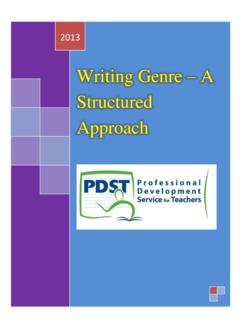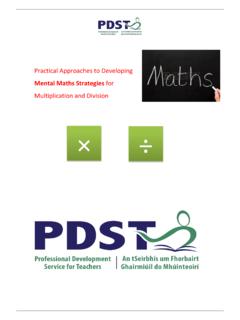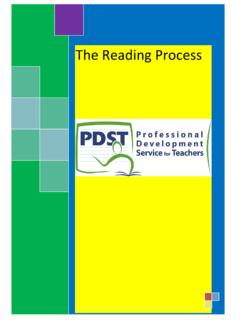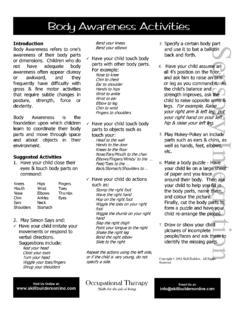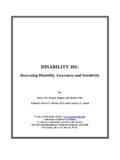Transcription of Activities to Develop Phonological Awareness - PDST
1 Primary Curriculum Support Programme Phonological Awareness in the Infant Classes Mair ad N Mhurch 1 Phonological Awareness Training through the Primary School. Developing Phonological Awareness in the Infant Classes Introduction Three levels of Phonological Awareness are attended to below: syllabic Awareness ; onset-rime Awareness ; phonemic Awareness . Within each section, Activities are presented more or less in sequential order for teaching. While it is possible to commence work on all levels at the same time it is probably more sensible to start work on syllables and onsets-rimes and then introduce phonemic Awareness exercises as children seem to be able for them. A. Activities to Develop Syllabic Awareness 1. Emphasising stressed syllables through clapping or other physical movement. Children can clap out the stressed syllables of any rhyme.
2 The rhymes of traditional games which involve clapping or movement of some sort are a good starting place for Phonological Awareness training in children. Phonemic Awareness in young Children: A Classroom Curriculum (Adams, Foorman, Lundberg and Beeler, p32) has an activity with the rhyme One potato, two potato, three potato, four Five potato, six potato, seven potato, more . Children sit in a circle with both fists before them. They chant the rhyme and the child who is on moves around inside the circle and gently pounds out the stressed syllables on each fist. The fist that gets pounded on for the last syllable in each line must be withdrawn and so on until only one fist is left! The same game can be played with lots of rhymes, Eeny, Meeny, Miney, Mo ; Please Porridge Hot . 2. Syllable Segmentation with Kinaesthetic Reinforcement Kinaesthetic reinforcement helps children segment syllables.
3 (i) A body place for each syllable! One way of providing kinaesthetic reinforcement is to get the children to use their two hands and to touch their heads for the first syllable, their shoulders for the second syllable, their hips for the third, knees for the fourth, toes for the fifth and heels if there is a sixth syllable! Children love this and they naturally experiment with any new words they hear. Such exercises also give children an Awareness of word length. All words which interest the children can be used for segmentation in this way. It s always a good idea to start with children s names. (ii) If You re Happy And You Know The Sounds Abound Programme (Lenchner & Podhajski, see of Manual) uses the well-known song If you re happy and you know it to practise syllable segmentation. Show a picture of a multisyllable word, television . Now sing the song: If you re happy and you know it, clap your hands (all now clap out the syllables of tel-e-vi-sion ) If you re happy and you now it, clap your hands Primary Curriculum Support Programme Phonological Awareness in the Infant Classes Mair ad N Mhurch 2 (repeat actions).
4 If you re happy and you know it then you really ought to show it, If you re happy and you know it, clap your hands (repeat clapping of tel-e-vi-sion as above) . Continue with other verses using different action directions, stamp your feet (stamping alternate feet for each syllable of tel-e-vi-sion ); tap your knees (tapping alternate knees for each syllable); raise your hands (raising alternate hands for each syllable), etc. (iii) Duck, Duck, Goose (adapted) This game is taken from The Sounds Abound Program (Lenchner & Podhajski, see p. 56 of Manual) and it is an adaptation of the traditional children s game Duck, Duck, Goose . Children sit in a circle. A picture card of a multisyllabic word can be shown to the group ( butterfly ) but a picture isn t absolutely necessary. One child is selected (we say this child is on ) and (s)he goes around the outside of the circle of children, saying the word but-ter-fly and tapping each child lightly on the back (once), one tap for each syllable of the word.
5 Having repeated the segmentation and tapping in this way a number of times, the child says the full word butterfly (at normal pace) as (s)he taps a child of his/her own choosing. This chosen child then stands up quickly and tries to catch the child who is on before the latter runs a complete circle etc. The game continues with other multisyllabic words. It will take children at Junior Infant level some time to get the one-to-one correspondence right one child, one tap, one syllable. 3. Syllable Counting with Fingers A very effective way of counting syllables in words is to have children put up one finger for each syllable (starting with the thumb for the first syllable) and let the fingers displayed until counting is completed. An activity children like to do is to group themselves according to the number of syllables in their first name and to discover which group is the biggest, etc. Syllable counting exercises can be based on whatever topic is being done.
6 For example, animals - see who can think of an animal with lots of syllables in its name! (They all the love the hipp- o-pot-a-mus !) Limit their choice by asking them to supply two-syllable words or three-syllable words only, etc. Sound Wizard Strategy Building Games for Phonological Awareness (Lenchner) has several small picture cards for playing syllable games each child chooses a picture card, counts the syllables and whoever has the picture card with the most syllables wins the round etc. 4. Syllable Isolation A good place to start syllable isolation is to use two-syllable words that also happen to be compound words, postman, playground, blutack, blackbird. Segment into its syllables and then ask the child to say the first part on its own, then the second part on its own. It helps to put two paper post-its side by side to represent the two syllables and to remove one as you want the children to omit the corresponding syllable.
7 A way of dealing with multisyllable words which are not compound words is to present, for example, a real carrot and cut it into two parts. Have the child touch each part as (s)he says the corresponding syllable. Point to one part of the cut carrot and ask them to say this part on its own. Other possibilities are spa-ghe-tti , ba-na-na , po-ta-to . Pictures of words can be cut up if you can t have the real object. Eventually, you should be able to present a multisyllable word and ask for its first, second, third, syllable etc. Primary Curriculum Support Programme Phonological Awareness in the Infant Classes Mair ad N Mhurch 3 5. Syllable Blending This involves the teacher saying words, leaving a one-second gap between each syllable. Children tell what word the teacher is saying. There are many possibilities for making a game out of this Helping Robbie Robot (who can only say words with an interval between syllables) to say words properly.
8 You can confine possibilities to a particular theme especially at the beginning children s names, months of the year, foods etc. Notes (i) Oral work on syllable segmentation anticipates the breaking up of words that children will have to do later when they are learning to read words. Too often teachers expect children to be able to visually break up words into syllables for decoding without having had any aural or oral experience of doing this with spoken words. (ii) Furthermore, such exercises help children to see how frequently some syllables occur. For example, suffixes such as ing and er can be well known to children at an aural and oral level before they encounter them in print. (iii) You may wish to use the term part of a word instead of syllable at the beginning but once children have the concept, the word syllable can be introduced and used from then on. B. Onset-Rime Awareness (Rhyming) There has been a renewed emphasis on nursery rhymes, rhyming stories, rhyming jingles etc serving not only language enrichment but also helping children to come to terms with the Phonological features of the language.
9 This emphasis has been reflected in the literacy materials available for children and such materials will play an important part in Phonological Awareness training. 1. Rhyme Recognition Exercises (i) I m thinking of a name that rhymes is a circle game from The Sounds Abound Program (Lenchner and Podhajski, see of Manual) that aims to Develop rhyme recognition. Children are in a circle and an empty chair is in the middle. The teacher sings (to the tune of Here we go around the Mulberry Bush ) I m thinking of a name that rhymes with plate (a word that rhymes with a child s name rhymes with plate , rhymes with plate I m thinking of a name that rhymes with plate And _____ Kate is the name! Kate sits on the chair in the middle and the teacher proceeds with the next verse, saying, as before, a rhyming word for a name in the class. The children should be able to join in in the last line of the verse.)
10 Several adaptations of this game are possible depending on the topic you wish to explore. For example, if studying the topic food , various food items can be given out to children and the verse can be adapted as follow: I m thinking of a food that rhymes with head .. (bread) Primary Curriculum Support Programme Phonological Awareness in the Infant Classes Mair ad N Mhurch 4 (ii) Activities with pictures that rhyme A set of pictures of rhyming words is an invaluable resource for developing Phonological Awareness . Children can be given the following kinds of Activities : Matching rhyming pictures from a set of picture cards (begin with a small number of cards and increase the number according to ability). Picking out the odd-one-out (picture that doesn t rhyme ) from a set of pictures. Pictures provide a concrete focus for rhyme discrimination work and having the picture in front of them while they think about the sounds reduces the auditory memory load for children compared to the task of discriminating between orally presented words.


